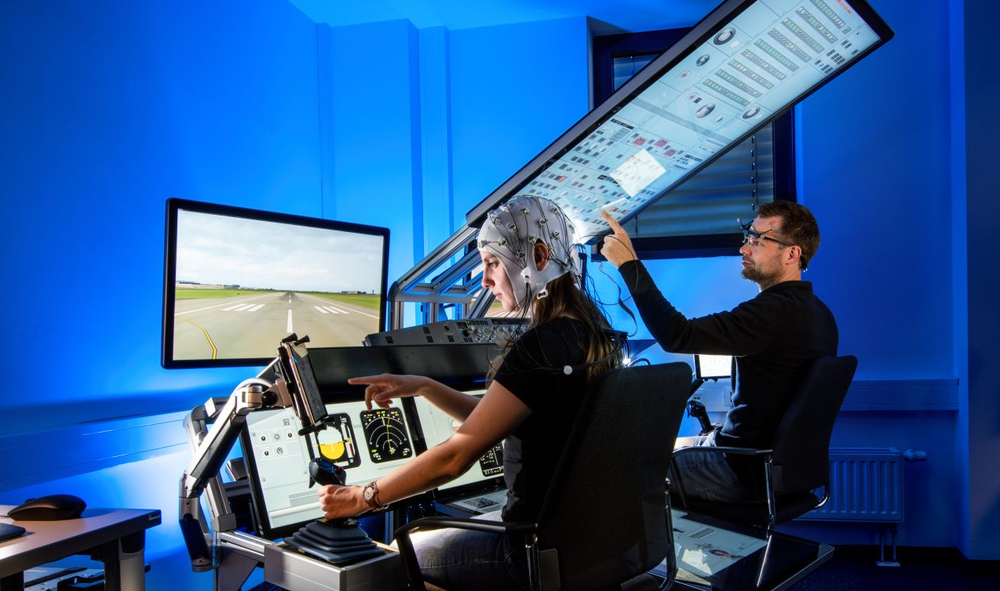HMI Lab

In the HMI Lab, researchers at the Institute test new interaction technologies for human-machine interaction, develop and test new measurement methodologies and investigate collaborative work processes.
The work in the HMI Lab results from the requirements and open questions of the Institute's application-oriented research. Here, test setups and studies take place that generate robust empirical statements in order to be able to make important design decisions in the early phases of concept development. With little effort, generic workplaces are designed on which the performance of air traffic controllers, pilots and teams can be investigated. A range of interaction and measurement technologies are available for this purpose.
Research areas
1. Innovative workplace for aviation operators
The laboratory offers the possibility to simulate operational concepts and workplaces in a simplified way in the early phases of their development. These include workstations that enable collaborative decision-making in airport management and flight guidance, virtual and augmented reality systems to support operators, but also a flexible cockpit simulator with touch displays. The focus here is on being able to quickly test novel concepts with human operators. It also allows to record the effect of these concepts, or components of the concepts, on the operator and performance. These results form a decision-making basis for further developments at the Institute.
2. Recording the condition of operators and their performance
When designing and evaluating highly automated or fully automated work environments, the effects on human cognition must be taken into account. For this reason, methods for recording and evaluating cognitive processes are being tested in the HMI Lab, which can be used in field trials or in operational use if suitable. These include eye movement measurement, EEG, fNIRS and so-called "wearables" for assessing metrics such as the heart rate.
Technical background
The HMI Lab is a highly flexible facility for answering fundamental questions about interaction in studies conducted together with laypersons and experts. The structure of the lab is divided into different functional areas:
- An area for collaborative work processes with eight computer workstations makes it possible to test several participants simultaneously in studies in a time-efficient manner. Collaborative decision-making situations can be simulated and examined here. With the help of partition walls, spatially separated multi-team systems can also be realized.
- A usability and eye movement measurement section contains infrastructure to specifically assess the usability of redesigned displays and perform non-contact eye movement measurements.
- A third area in the HMI Lab is the cockpit simulator iSIM with touch-input displays, which can map all cockpit displays and controls and allows researchers to easily change and expand the displays and controls. The low-fidelity simulation of a cockpit is particularly suitable for early phases of the development of new displays and new design concepts, for example on the possible use of mobile devices or virtual reality / augmented reality in the cockpit.
- Depending on requirements and the focus of the study, an experimental supervisor's workstation and a debriefing area can also be set up flexibly. This allows experiments to be controlled and debriefed directly afterwards.
Measuring cognitive processes
Using various measuring instruments and methodologies, cognitive and physiological parameters can be recorded in the HMI Lab to draw conclusions about the state of the person and their performance: Are they exhausted? Overstrained? Or bored? Such measurements can be faster and more accurate than mere observations of performance and more objective than self-reports. Small, lightweight and portable devices allow for use in laboratory contexts as well as in realistic studies.
The following methods are used individually or even in combination in the HMI Lab:
- EEG (electroencephalography) to measure electrical brain activity. Key data: LiveAmp 32: portable 32-channel EEG with active ActiCap Slim electrodes (BrainProducts GmbH); EASYCAP caps (EASYCAP GmbH).
- fNIRS (functional near infrared spectroscopy) to measure changes in cerebral blood oxigenation. Key data: NIRSport 2: portable dual-wavelength LED fNIRS with 8 sources and detectors each and additional short-distance detectors (NIRx Medizintechnik GmbH); compatible with EASYCAP caps (EASYCAP GmbH).
- Two pairs of Eye-Tracking Glasses: SMI Eye-Tracking Glasses 2 Wireless (SensoMotoric Instruments) and one pair of TobII Glasses 2.
- VR goggles with integrated eye movement system for measuring eye movements in virtual environments. Key data: HTC Vive Pro Eye, wired VR goggles with 110-degree field of view and 20 pixels per degree resolution; integrated Tobii eye movement measurement; powered by an NVIDIA GeForce RTX 2080 graphics card.
- ECG (electrocardiogram) for measuring the electrical activity of the heart. Key data: Smart belt: wearable chest belt with software for PC and tablet for real-time measurement, transmission and evaluation of ECG (heart rate (HR) and heart rate variability (HRV)), breathing rate, body temperature and activity.
